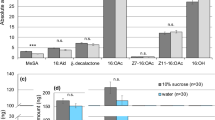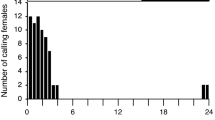Abstract
The Noctuidae are one of the most speciose moth families and include the genera Helicoverpa and Heliothis. Females use (Z)-11-hexadecenal as the major component of their sex pheromones except for Helicoverpa assulta and Helicoverpa gelotopoeon, both of which utilize (Z)-9-hexadecenal. The minor compounds found in heliothine sex pheromone glands vary with species, but hexadecanal has been found in the pheromone gland of almost all heliothine females so far investigated. In this study, we found a large amount (0.5–1.5 μg) of hexadecanal and octadecanal on the legs of males of four heliothine species, Helicoverpa zea, Helicoverpa armigera, H. assulta, and Heliothis virescens. The hexadecanal was found on and released from the tarsi, and was in much lower levels or not detected on the remaining parts of the leg (tibia, femur, trochanter, and coxa). Lower amounts (0.05–0.5 μg) of hexadecanal were found on female tarsi. This is the first known sex pheromone compound to be identified from the legs of nocturnal moths. Large amounts of butyrate esters (about 16 μg) also were found on tarsi of males with lower amounts on female tarsi. Males deposited the butyrate esters while walking on a glass surface. Decapitation did not reduce the levels of hexadecanal on the tarsi of H. zea males, indicating that hexadecanal production is not under the same neuroendocrine regulation system as the production of female sex pheromone. Based on electroantennogram studies, female antennae had a relatively high response to hexadecanal compared to male antennae. We consider the possible role of aldehydes and butyrate esters as courtship signals in heliothine moths.






Similar content being viewed by others
References
Al Bitar L, Voigt D, Zebitz CP, Gorb SN (2009) Tarsal morphology and attachment ability of the codling moth Cydia pomonella L. (Lepidoptera, Tortricidae) to smooth surfaces. J Insect Physiol 55:1029–1038
Al Bitar L, Voigt D, Zebitz CP, Gorb SN (2010) Attachment ability of the codling moth Cydia pomonella L. To rough substrates. J Insect Physiol 56:1966–1972
Attygalle AB, Aneshansley DJ, Meinwald J, Eisner T (2000) Defense by foot adhesion in a chrysomelid beetle (Hemisphaerota cyanea): characterization of the adhesive oil. Zoology 103:1–6
Baker TC, Nishida R, Roelofs WL (1981) Close-range attraction of female oriental fruit moths to herbal scent of male hairpencils. Science 214:1359–1361
Birch MC, Poppy GM, Baker TC (1990) Scents and eversible scent structures of male moths. Annu Rev Entomol 35:25–58
Böröczky K, Park KC, Minard RD, Jones TH, Baker TC, Tumlinson JH (2008) Differences in cuticular lipid composition of the antennae of Helicoverpa zea, Heliothis virescens, and Manduca sexta. J Insect Physiol 54:1385–1391
Cho JR, Boo KS (1988) Behavior and circadian rhythm of emergence, copulation and oviposition in the oriental tobacco budworm, Heliothis assulta Guenée. Korean J Appl Entomol 27:103–110
Choi MY, Han KS, Boo KS, Jurenka RA (2002) Pheromone biosynthetic pathways in the moths Helicoverpa zea and Helicoverpa assulta. Insect Biochem Mol Biol 32:1353–1359
Cork A, Boo KS, Dunkelblum E, Hall DR, Jee-Rajunga K, Kehat M, Kong Jie E, Park KC, Tepgidagarn P, Xun L (1992) Female sex pheromone of oriental tobacco budworm, Helicoverpa assulta (Guenee) (Lepidoptera: Noctuidae): identification and field testing. J Chem Ecol 18:403–418
Cork A, Lobos EA (2003) Female sex pheromone components of Helicoverpa gelotopoeon: first heliothine pheromone without (Z)-11-hexadecenal. Entomol Exp Appl 107:201–206
Delle-Vedove R, Beaudoin-Ollivier L, Hossaert-Mckey M, Frerot B (2012) Reproductive biology of the palm borer, Paysandisia archon (Lepidoptera: Castniidae). European J Entomol 109:289–292
Delle-Vedove R, Frerot B, Hossaert-McKey M, Beaudoin-Ollivier L (2014) Courtship behavior of the castniid palm borer, Paysandisia archon: potential roles of male scents and visual cues in a day-flying moth. J Insect Sci 14
Dussourd DE, Harvis CA, Meinwald J, Eisner T (1991) Pheromonal advertisement of a nuptial gift by a male moth (Utetheisa ornatrix). Proc Natl Acad Sci U S A 88:9224–9227
El-Sayed AM (2014) The Pherobase: Database of pheromones and semiochemicals http://www.pherobase.com
Frerot B, Delle-Vedove R, Beaudoin-Ollivier L, Zagatti P, Ducrot PH, Grison C, Hossaert M, Petit E (2013) Fragrant legs in Paysandisia archon males (Lepidoptera, Castniidae). Chemoecology 23:137–142
Geiselhardt S, Otte T, Hilker M (2009) The role of cuticular hydrocarbons in male mating behavior of the mustard leaf beetle, Phaedon cochleariae (F.). J Chem Ecol 35:1162–1171
Groot AT, Blanco CA, Claen A, Inglis O, Santangelo RG, Lopez J, Heckel DG, Schal C (2010) Variation in sexual communication of the tobacco budworm. Heliothis virescens Southwestern Entomol 35:367–372
Heath RR, Landolt PJ, Dueben BD, Murphy RE, Schneider RE (1992) Identification of male cabbage looper sex-pheromone attractive to females. J Chem Ecol 18:441–453
Hillier NK, Vickers NJ (2004) The role of heliothine hairpencil compounds in female Heliothis virescens (Lepidoptera: Noctuidae) behavior and mate acceptance. Chem Senses 29:499–511
Hillier NK, Vickers NJ (2007) Physiology and antennal lobe projections of olfactory receptor neurons from sexually isomorphic sensilla on male Heliothis virescens. J Comp Physiol A Neuroethol Sens Neural Behav Physiol 193:649–663
Hillier NK, Vickers NJ (2011) Hairpencil volatiles influence interspecific courtship and mating between two related moth species. J Chem Ecol 37:1127–1136
Hillier NK, Kleineidam C, Vickers NJ (2006) Physiology and glomerular projections of olfactory receptor neurons on the antenna of female Heliothis virescens (Lepidoptera: Noctuidae) responsive to behaviorally relevant odors. J Comp Physiol A Neuroethol Sens Neural Behav Physiol 192:199–219
Hillier NK, Kelly D, Vickers NJ (2007) A specific male olfactory sensillum detects behaviorally antagonistic hairpencil odorants. J Insect Sci 7:4
Jacquin E, Nagnan P, Frerot B (1991) Identification of hairpencil secretion from male Mamestra brassicae (L) (Lepidoptera, Noctuidae) and electroantennogram studies. J Chem Ecol 17:239–246
Jurenka RA (2003) Biochemistry of female moth sex pheromones. In: Blomquist G, Vogt R (eds) Insect pheromone biochemistry and molecular biology. Academic Press, New York, pp. 53–80
Klun JA, Bierlleonhardt BA, Plimmer JR, Sparks AN, Primiani M, Chapman OL, Lepone G, Lee GH (1980a) Sex pheromone chemistry of the female tobacco budworm moth, Heliothis virescens. J Chem Ecol 6:177–183
Klun JA, Plimmer JR, Bierlleonhardt BA, Sparks AN, Primiani M, Chapman OL, Lee GH, Lepone G (1980b) Sex peromone chemistry of female corn earworm moth, Heliothis zea. J Chem Ecol 6:165–175
Ma PWK, Ramaswamy SB (2003) Biology and ultrastructure of sex pheromone producing tissue. In: Blomquist G, Vogt R (eds) Pheromone biochemistry and molecular biology. Elsevier, London, pp. 19–51
Matthews M (1991) Classification of the Heliothinae. Natural Resources Institute Bulletin 44:1–198
Monteys VSI, Acin P, Rosell G, Quero C, Jimenez MA, Guerrero A (2012) Moths behaving like butterflies. Evolutionary loss of long range attractant pheromones in castniid moths: a Paysandisia archon model. PLoS One 7:e29282
Nieberding CM, de Vos H, Schneider MV, Lassance JM, Estramil N, Andersson J, Bang J, Hedenstrom E, Lofstedt C, Brakefield PM (2008) The male sex pheromone of the butterfly Bicyclus anynana: towards an evolutionary analysis. PLoS One 3:e2751
Nishida R, Baker TC, Roelofs WL (1982) Hairpencil pheromone components of male oriental fruit moths, Grapholitha molesta (Lepidoptera, Tortricidae). J Chem Ecol 8:947–959
Park KC, Baker TC (2002) Improvement of signal to noise ratio in electroantennogram responses using multiple insect antennae. J Insect Physiol 48:1139–1145
Park KC, Hardie J (2004) Electrophysiological characterisation of olfactory sensilla in the black bean aphid, Aphis fabae. J Insect Physiol 50:647–655
Rafaeli A (2009) Pheromone biosynthesis activating neuropeptide (PBAN): regulatory role and mode of action. Gen Comp Endocrinol 162:69–78
Ramaswamy SB, Randle SA, Ma WK (1985) Field evaluation of the sex pheromone components of Heliothis virescens (Lepidoptera: Noctuidae) in cone traps. Environ Entomol 14:293–296
Sugie H, Tatsuki S, Nakagaki S, Rao CBJ, Yamamoto A (1991) Identification of the sex pheromone of the oriental tobacco budworm, Heliothis assulta (Guenee) (Lepidoptera, Noctuidae). Appl Entomol Zool 26:151–153
Teal PE, Tumlinson JH (1989) Isolation, identification, and biosynthesis of compounds produced by male hairpencil glands of Heliothis virescens (F.) (Lepidoptera: Noctuidae). J Chem Ecol 15:413–427
Tillman JA, Seybold SJ, Jurenka RA, Blomquist GJ (1999) Insect pheromones - an overview of biosynthesis and endocrine regulation. Insect Biochem Mol Biol 29:481–514
Vetter RS, Baker TC (1983) Behavioral responses of male Heliothis virescens in a sustained-flight tunnel to combinations of seven compounds identified from female sex pheromone glands. J Chem Ecol 9:747–759
Votsch W, Nicholson G, Muller R, Stierhof YD, Gorb S, Schwarz U (2002) Chemical composition of the attachment pad secretion of the locust Locusta migratoria. Insect Biochem Mol Biol 32:1605–1613
Acknowledgments
We thank the late Dr. Peter Teal for providing 16:Ald, Anne Barrington for supplying H. armigera for the EAG study, and Drs. CY Yang and JK Jung for technical help. A portion of this study was funded by Research Grant IS-4722-14 from BARD, the United States-Israel Binational Agricultural Research and Development Fund to RJ.
Author information
Authors and Affiliations
Corresponding author
Electronic Supplementary Material
ESM 1
(DOCX 390 kb)
Rights and permissions
About this article
Cite this article
Choi, MY., Ahn, SJ., Park, KC. et al. Tarsi of Male Heliothine Moths Contain Aldehydes and Butyrate Esters as Potential Pheromone Components. J Chem Ecol 42, 425–432 (2016). https://doi.org/10.1007/s10886-016-0701-3
Received:
Revised:
Accepted:
Published:
Issue Date:
DOI: https://doi.org/10.1007/s10886-016-0701-3




